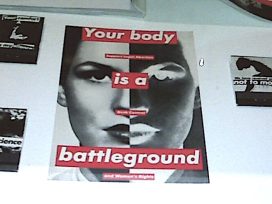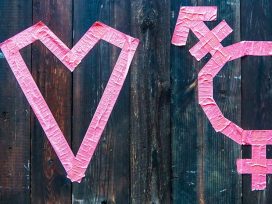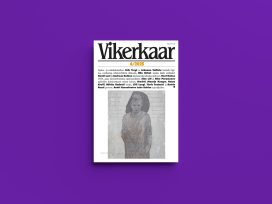Asexual and aromantic communities have long been marginalized within psychology, sociology and medicine. When acknowledged, they are pathologized as deviant groups whose ‘conditions’ require treatment. This double negation has resulted in the real experiences of asexual and aromantic people being pushed into obscurity.
The term ‘asexuality’ defines the sexual orientation of individuals who do not experience sexual desire or are not sexually attracted to others to the extent that ‘allosexual’ people typically are. ‘Aromanticism’ describes the romantic orientation of those who do not feel the desire for romantic relationships or are not romantically attracted to others. Both terms are also used as umbrella concepts for a range of identities on the asexual spectrum.
Most people, regardless of education or sexual orientation, do not distinguish between sexuality and romantic attraction for a very simple reason: they have never needed to. As philosopher Elizabeth Brake described in 2011, we live in an ‘amatonormative’ world. Across cultures and historical periods, romantic and sexual relationships, epitomized by marriage, have been viewed as the cornerstone not only of human experience but of legal structures as well. Those who, for any reason, do not participate in these structures have been systematically excluded.
A historical overview
One of the greatest challenges in studying queer history, especially that of aromantic and asexual individuals, is silence. What remains is the task of piecing together fragments, studying details, reading between the lines and recognizing our own experiences within them. Although the following historical examples do not explicitly reference asexuality or aromanticism – the terminology is relatively new – they reflect alternative ways of living, forming community and expressing love.
Early examples of asexuality can be found within various women’s communities. Though they functioned by different rules, these communities shared core values: protection, solidarity, autonomy and a refuge from oppressive heterosexual marriage – for queer and heterosexual women alike, particularly asexual women. The beguinages of thirteenth-century Flanders, now UNESCO World Heritage Sites, were small, fortified towns with their own churches, green spaces, shops and homes created in response to women’s need for safety during wars that ravaged Europe. In addition to Belgium, similar communities existed in France and the Netherlands. Although they did not belong to religious orders, women led lives reminiscent of monastic life within beguinage walls.
From the seventeenth century until 1949, the Golden Orchid Society in China offered its members an alternative and more favourable way of life than that which awaited them in heterosexual marriage. Women could marry one another either out of convention or genuine affection. Notably, among its extensive list of laws and rules, which included financial independence and land ownership, special provision was made for those who wished for no form of partnership – women we would now describe as asexual and aromantic. They symbolically married themselves in ceremonies, in which they styled their hair in the traditional manner of married women. There are even records of women who lived in non-sexual, romantic marriages with their partners.
Catherine Bernard, a seventeenth-century French author, is often cited as asexual. Bernard never married and lived alone in Paris, successfully earning her living from writing, which relates asexual and aromantic ideals. Les Malheurs de l’amour, a series of four novellas, opens with an introduction to Bernard’s inspiration: the chaos she saw even in the sincerest of loves, which led her to portray the troubles caused by passion rather than couples who live happily ever after. She describes an experience to which many people on the asexual spectrum can identify: romantic and sexual relationships are messy, chaotic and far from fulfilling – certainly not to the extent that society assumes they are.
With the emergence of sexology in the late nineteenth century, the existence of individuals who did not experience sexual attraction became more visible. However, sexologists such as Richard von Krafft-Ebing, who coined the term anaesthesia sexualis, classified asexuality as mental illness. While medical terminology would change over the decades that followed, diagnosing a lack of sexual attraction as a dangerous deficiency requiring treatment unfortunately remains a prevalent practice in both medicine and psychiatry today.
By the late twentieth century, awareness of asexuality began to slowly grow. Many queer magazines published articles about asexual individuals, activists began to include asexuality as part of the wider LGBTQIA+ community and academic works emerged that significantly contributed to discourse surrounding asexuality. In 2001, two major online spaces for asexual people were created: the Yahoo group Haven for the Human Amoeba, and the Asexuality Visibility and Education Network (AVEN). Some of the most recognizable symbols of the queer community – the asexual pride flag and asexuality visibility day – were only established in the past 15 years. The first Ace Week, a week of asexual visibility, was first held in October of 2010, and International Asexuality Day was only proclaimed in 2021, taking place annually on 6 April.
Medical classifications and pathologization
Like many other sexual orientations, asexuality has been subjected to medical classification and was long considered a sexual disorder. The tenth revision of the World Health Organization’s International Classification of Diseases (ICD-10), published in 1992, does not explicitly mention asexuality. Instead, it lists long-standing diagnoses such as Hypoactive Sexual Desire Disorder, sexual aversion and various disorders of sexual desire, with a particular note to frigidity as a sexual dysfunction specifically attributed to women.
Currently, a lengthy process is underway to implement the updated ICD-11, which, although removing frigidity as a medical diagnosis, does not go as far as recognizing asexuality as a valid sexual orientation.
Since the mid-twentieth century, the American Psychiatric Association has published the well-known Diagnostic and Statistical Manual of Mental Disorders (DSM-5), which, over its five editions, has continually expanded definitions of Hypoactive Sexual Desire Disorder, with little hope for imminent change.
In its most recent edition, DSM-5 (2013), the manual includes both Female Sexual Interest/Arousal Disorder (FSIAD) and Male Hypoactive Sexual Desire Disorder (MHSDD). For the first time in medical classification, asexuality is mentioned in a note:
‘If a lifelong lack of sexual desire is better explained by one’s self-identification as “asexual”, then a diagnosis of female sexual interest/ arousal disorder would not be made.’
and ‘If the man’s low desire is explained by self-identification as an asexual, then a diagnosis of male hypoactive sexual desire disorder is not made.’
At first glance, this may seem like a victory for the asexual community. However, the criteria necessary for a sexual disorder diagnosis include distress, burden and emotional discomfort as core factors.
Issuing a diagnosis to someone who may be experiencing distress due to their identity, rather than a medical condition, is unethical, especially if that individual is unaware of asexuality and therefore unable to provide a fully informed response to medical professionals. Not all stress related to identity, discrimination, or confusion over labels should be pathologized. This is precisely why the binary between ‘good’ asexuality and ‘bad’ sexual disorders is hurtful in both ways. Medical professionals should be educated about the spectrum of sexuality and romantic orientation, and in turn, not demonize sexual disorders and subsequent mental and social sequelae.
In 2020, researchers Shelby K. Flanagan and Heather J. Peters of the University of Minnesota conducted an online survey involving 136 participants of U.S. citizenship (with a minority from Europe and Australia) who identified as asexual. Flanagan and Peters investigated the participants experiences within their respective healthcare systems and explored whether there were differences in how various healthcare professionals approached asexuality.
Although participants were more likely to disclose their sexuality to therapists, they still reported negative experiences within the healthcare system. Nearly a quarter to half of respondents (31-50%) said their asexuality had been attributed to a medical condition or dismissed outright, which reinforced existing feelings of fear, discomfort and avoidance of the topic altogether.
These findings mirror those of Anthony Bogaert, a Canadian psychologist best known for pioneering research on asexuality, who argued that the ‘origin’ of a sexual orientation does not render it pathological or less valid. One survey respondent from 2020 stated that it does not matter whether he was born asexual or not – what matters is that this is how he functions now, and it is not something that needs fixing. Asexuality is a valid sexual orientation – how one arrives at that identity does not diminish its validity.
Contemporary mythology
Numerous misconceptions persist about asexuality and aromanticism, especially the latter which has been far less researched than asexuality and has only come into broader focus over the past five years. In 2024 James Fowler of the University of Queensland, alongside his co-workers, partnered with AUREA (Aromantic-spectrum Union for Recognition, Education and Advocacy), a global aromantic community organization, and published an international qualitative study, using an open-ended survey on misconceptions about aromanticism. A total of 1,642 individuals from around the world, who identify (at least) as aromantic participated, answering questions about how they experience their romantic orientation and how those around them perceive their aromanticism.
A common thread in the experiences of survey participants in romantic relationships was the presence of stigma. Participants predominantly reported feelings of fear of pity from their partners, and were labelled as ‘inhuman’, ‘insensitive’, ‘incapable of emotion’, ‘immature’, ‘selfish’, ‘cruel’, ‘incomplete’, or ‘ill’. They were told they were simply seeking attention, that they were frauds, incapable of committing to a relationship, that they were sexual predators, and, of course, that it was all ‘just a phase’.
Although these experiences were specifically tied to aromanticism, they are not inapplicable to asexuality or to any other ‘absence’ of traits that society considers to be the norm. Such misconceptions often lead to both internalized and socially anticipated stigma, which in turn results in the suppression of identity and a feeling of existing in a vacuum.
Impact on mental health
Identity crises and intrapersonal conflict are near inevitable in the lives of people on the asexual spectrum. Often, individuals feel more secure in their orientation than in the social environments that surround them. Discrimination occurs not only within healthcare systems and families but also within the LGBTQIA+ community itself. As a result, social isolation can lead to a cycle of voluntary withdrawal from socializing and forming connections and further stigmatization.
Asexual and aromantic people frequently experience epistemic injustice: they are stigmatized within the social sciences and excluded from research and queer theory discourse by other researchers, sociologists and psychologists.
Research by Yule et al. in 2013 found that asexual individuals are statistically more likely to experience anxiety and depressive disorders, suicidal thoughts, and difficulties in interpersonal relationships compared to heterosexual and homosexual individuals. These diagnoses are consequential to the discrimination they experience but are often attributed as primary diagnoses by healthcare professionals – asexuals are often diagnosed with a depressive disorder due to reduced sexual desire, autism spectrum disorders, developmental delays and schizoid personality disorder.
Beyond the community framework
Challenging social norms and provoking reflection on the nature of human experience is vital to understanding asexuality and aromanticism. The unwritten rule of our times is that an individual achieves self-actualization only through cohabitation with another human being in a romantic and, eventually, a sexual relationship. Without this, one is perceived as nothing. But how can one dictate to another how to be happy? Claiming that sexual intimacy is the pinnacle of human essence, human identity and desire does not make us as valuable as many people think.
The asexual spectrum, with all its nuances, does not represent an absence of love or desire. Instead, it is a rather quiet yet radical severance of humanity from ‘sexuality’ and a disruption of the privilege placed on the physical over the emotional. Human worth is inherent in everyone and does not, and will never, depend on the kind of connection one has with other human beings.
Human love is neither predestined nor limited. It is as unique as a fingerprint to each person. It is something we feel – and something we won’t ever be able to measure.
This article was first published by Vox Feminae. Its translation from Croatian into English was commissioned as part of Come Together, a project leveraging existing wisdom from community media organization in six different countries to foster innovative approaches.








